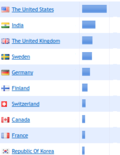 There we go, with my cloud file sharing service dead in the water thanks to AVMs lousy software that they don't want to fix anytime soon I had to look for other options to turn the tide and convert a defeat into a victory. To recap, I sometimes need to share large files and don't want to use Dropbox like services that require my data to go out to a server somewhere on the web.
There we go, with my cloud file sharing service dead in the water thanks to AVMs lousy software that they don't want to fix anytime soon I had to look for other options to turn the tide and convert a defeat into a victory. To recap, I sometimes need to share large files and don't want to use Dropbox like services that require my data to go out to a server somewhere on the web.
While thinking about alternatives I remembered that I once came accross ownCloud, an open source software that should do just what I wanted. And indeed after having taken a closer look it seemed to be exactly what I wanted. Then I remembered a low cost, low power computer called Rasperry Pi that runs Linux, perhaps a perfect base for running ownCloud inexpensively? And indeed, a Google search revealed how to install ownCloud on a Pi in just a few steps.
To see if ownCloud would be a solution for me, I downloaded a virtual machine image with a x86 Suse Linux base and ran it in Virtualbox on my PC. I came away very impressed about how easy it was to create users in ownCloud and how to share files by creating URLs in the browser. Also, uploading files via WebDAV as an additional convenience worked out of the box. Perfect! So I decided to go for the Raspberry solution and ordered one for next day delivery.
Needless to say I could hardly wait for its arrival but at least I could busy myself with preparing a couple of SD cards to boot it from. For a quick start, a Pi enthusiast has already created an SD card image with ownCloud preinstalled, so I used that for my first steps. In addition I downloaded the original Raspian Pi image to install ownCloud from scratch lateron.
As expected the Pi was delivered the next day and getting it up and running was as simple as connecting it to a mobile phone charger via USB to supply power and to plug in an Ethernet cable for connectivity. For the first experiments I also used a keyboard, mouse and monitor but quickly switched to a network only configuration as for the few cases in which I need a graphical user interface on the PI I can run that over the network using X11VNC.
Since I had ownCloud preconfigured on the SD card image I could log in immedately via the web browser and could start using it. With wired connectivity, I could read and write files at around 30 MBit/s. That doesn't sound like much at first but since the main use will later on be over Wi-Fi which is limited to around 25 Mbit/s at my place and over VDSL with a 5 Mbit/s uplink speed it is enough for my purpose. Also, the Pi only runs on around 2 Watts (!), which will only add around 3-4 Euros per year to my engery bill. So I think the 30 Mbit/s is a good compromise.
The final step was installing ownCloud on a plain Raspian image which also just took half an hour at most thanks to this tutorial, including the extra configuration for having a 5 GB system partition and a 10 GB data partition on the SD card and configuring the mount in fstab manually.
So for 60 Euros including the 16 GB SD card, a 3-4 euros per year power bill and a lot of fun setting the whole thing up I have my own file server now that I can use to share documents with other people on the fly. I really like that!
But of course I couldn't stop there because ownCloud can also synchronize calenders and address books between devices, something I don't want Google or anyone else do for me and from which I so far always refrained from. In a follow up post, I'll describe how that went. So stay tuned.


